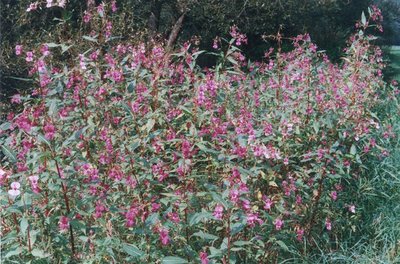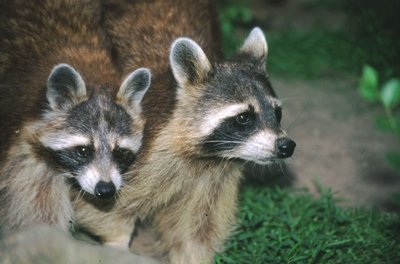Foreign animals and plants brought to Germany are often described as "intruders" by the media in these days. In Germany, 1322 "new" animal species have been detected so far, 262 of which are already completely established in our ecosystems.
The most discussed species are those which are particularly striking or detrimental, for example in agricultural terms. The great importance of the forest on the one hand, and of the species brought to or introduced in it on the other hand, is too much neglected in most studies.
All forest topics are concerned
From our point of view, many domains of forest and forestry are concerned in the issue of introduced species. Forestry itself contributed to this topic as well, for example by introducing exotic tree species for silvicultural reasons, like douglas fir, northern white pine, red oak, black locust and black cherry.
A large thematic field touched by neozoics and neophytes is the forest protection. The Dutch elm disease and the white pine blister rust (Cronartium ribicola) are examples for fungus diseases which did not occur in our nature until they were accidentally introduced, and have caused serious damages since then. The new alder disease which seems to be the result of a hybridisation of two Phytopthora species, is a new phenomenon for Middle Europe.
Traditionally, the domains of hunting and wildlife ecology are also concerned in the topic "new species"/ "Neobiota", as several of our game species are part of the class of neozoics, like fallow deer and mouflons, pheasant and rabbit, raccoon, raccoon dog and American mink.
Do neozoics endanger the biodiversity?
At the moment, people interested in nature protection as well as the public in general pay a lot of attention to biological invasions. The agreement on the biodiversity (CBD) as a concrete result of the summit conference about the development of nature in Rio de Janeiro (June 1992) has assigned the invasive exotic species to those processes which endanger the biodiversity. Article 8 (h) expresses the obligation "to impede – as far as possible and if reasonable – the introduction and integration of alien species which endanger ecosystems, habitats and other species, and to control or remove these species." However, the decisive aspect of this issue is the question if the ecosystems, habitats and species are really endangered.
Many examples from all over the world illustrate the negative influence which newly introduced plant and animal species exert on the existing flora and fauna. In most cases, however, these examples concern islands or other biotopes which are isolated in some way (for example Lake Victoria/Nile perch). On the Galapagos Islands, a project exists to free the unique flora and fauna from the introduced dogs, cats, rats and goats. On Hawaii, 23 of the 67 indigenous bird species have already died since the discovery of the island – also in assistance of introduced species which turned out to be better competitors. On the Pacific island Guam, 21 endemic animal species have been exterminated so far by the Brown tree snake introduced form Australia during World War II.
In Middle Europe, however, the ecological risk has to be judged differently. There has never been the comparable situation that an indigenous plant or animal species was exterminated by an introduced one. But it is also not right to exclude that this has already occurred or will happen in future. The successful integration of new species requires the interaction of a large number of different factors.
The actual problem of many exotic plant and animal species is the fact that they are often discussed in an ideological, and not in an objective and professional manner. But we also have to keep in mind that our ecosystems are never static, but always dynamic with constant changes.
Neobiota
This is the term for all organisms in general which were brought on purpose or by chance in territories naturally inaccessible for them since 1492 (discovery of America) and which (still) succeed in reproduction and spreading.Neozoics
According to the definition, neozoics are animal species which came to a certain territory with direct or indirect human assistance and which live there in wildness since 1492 (about 1.300 neozoics species exist in Germany).Neophytes
This term is used to describe introduced or integrated plant species since the discovery of America. Besides particularly striking species like the American Waterweed (Elodea canadensis) or the Himalayan Balsam (Impatiens glandulifera), tree species which are relevant for forestry are also part of the neophytes, like red oak, northern white pine and douglas fir.Neomycetes
Fungi which have been introduced since 1492. At least 41 not indigenous large fungi have already been found in Germany.
Plant protection as an urgent task
To impede the dispersal of foreign noxious organisms, different laws and legal regulations do exist at the moment. The legal basis for quarantine measures is given by the Council’s guideline 2000/29/EG. In Germany, the plant protection services of the federal states are responsible for the carrying out of plant supervisions and the organisation of the corresponding measures. This is, for example, the Institute for Agriculture (Landesanstalt für Landwirtschaft, LfL) in Bavaria.
These strict quarantine regulations allowed for example to prevent successfully the protraction of the dangerous American oak disease (caused by Ceratocystis fagacearum) in Middle Europe. The Asian long-horned beetle (Anoplophora glabripennis), the pine wood nematode (Bursaphelencus xylophilus) and Phytophthora ramorum also belong to the class of new quarantine imposing vermin. The introduction of plant and animal species with damage potential particularly for indigenous tree species requires an attentive observation of existing stands by foresters and forest owners. The warning examples of the Dutch elm disease and the white pine blister rust should be taken seriously. Not panicmongering should be the aim, but the objective information about the damaging potential of such pathogenes. It is therefore also necessary to inform sufficiently forest personnel about damage potential and the symptomatic of the diseases and to engage further education in order to be able to implement competent controls on the spot.
Archaeophytes and archaeozoics
Archaeophytes and archaeozoics are animals and plants which were already integrated in a certain territory since the prehistoric or the earliest historic age. The majority was brought in or naturalised during the beginning of farming and the development of the bigger settlements of the Late Stone Age, the neolithicum. Many cultivated plants belong to this class, like wheat or wine as well as the most field weeds (cornflower, f. ex.). But also tree species like European chestnut (Castanea sativa) and walnut (Juglans regia) were already cultivated in climatic favourable regions in Germany by the Romans and are hardly considered as "strangers" nowadays.
Packaging wood as a source of danger
The movements of goods all over the world as a consequence of the increasing globalisation contributes involuntary to the process by which detrimental organisms cross borders and invade an increasing number of countries. For forest and forestry, imported wood package plays a particularly decisive role. One example: The Asian long-horned beetle was brought in to Austria in packaging wood and couldn’t be exterminated so far.
70 % of all container cargoes contain packaging wood or stow wood in some way. A detailed control by plant protection services is often hardly possible. According to a risk analysis of the USA, 97 % of all tree vermin are associated to packaging wood (Schröder 2004). It is important to recognise and determine new damages or noxious organisms as fast as possible. For ensuring this, attention on the spot as well as specialists, for example in forest entomology and mycology, are necessary to observe the phytosanitary standards (Schorn/Unger 2003).
Invasive species
Invasive species are those which – once brought in – spread rapidly and which give cause for concern: for ecological, economic or health related reasons.Not every alien species is "invasive". Many species are brought in, but disappear soon after they have occurred, or they adapt to the existing ecosystem. Others, however, endanger the indigenous nature by changing the environment, suppressing native species or by hybridisation and inbreeding of new genetic material. For foreign (allochthone) species which invade, disturb or even destroy indigenous (autochthone) plant associations, the term "invasive species" has established during the last years.As an example of invasive species, the Giant Hogweed (Heracleum mantegazzianum) or the bullfrog (Rana catesbaiana) can be mentioned.
Enrichment or threat to our forests?
The simple the question seems to be, the difficult it is to answer. A majority of the introduced alien plant and animal species will adapt without greater difficulties to our ecosystems, as long as free ecological niches do exist, and keep existing there in a more or less unobtrusive way. A small part, however, has to be observed with more attention considering their risk potential. Nevertheless, controlling measures will only be implemented after a cost-benefit-analysis in isolated cases. If measures for controlling neophytes in forests are planned, it first has to be considered critically if this species in fact threatens or suppresses indigenous living spaces or species, or impedes the regeneration of stands suited to site.
All in all, we should take care not to make a hasty judgement on newly introduced plant and animal species. Under no circumstance, we should let us overwhelm by hysteria and "eco-fascism". At the same time, however, we should not belittle these species in particular. We have to observe them attentively and, if a damage risk is known, impede the introduction to Middle Europe by a consequent carrying out of plant controls. To ensure this, detailed observations and contactable experts on the spot are indispensable.


